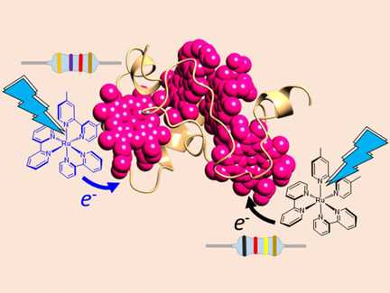Multiheme cytochromes are proteins notable for their electron transfer properties. As Nature’s solution to long-range electron transfer, these proteins are spanned by chains of closely packed heme groups. Electron transfer across and between these cytochromes occurs by complementary Fe(III)/Fe(II) transitions at neighboring centers.
Julea N. Butt and colleagues, University of East Anglia, UK, have engineered multiheme cytochromes that can be used as biohybrid phototransducers for converting light into electricity. The team site-selectively functionalized the small tetraheme cytochrome (STC) with Ru(II)(2,2′-bipyridine)3 at five different sites.
When irradiated with visible light, the Ru(II)(2,2′-bipyridine)3 photo-trigger injects photoenergized electrons into the STC’s four-heme chain. These electrons become trapped in the protein when the oxidized Ru complex receives electrons from a sacrificial electron donor such as EDTA (ethylenediaminetetraacetic acid).
The biohybrid materials act as phototransducers of light to electricity. Their behavior varies depending on the site of the functionalization and, thus, electron injection. Some of the materials act more like resistors and others like wires. The researchers believe these findings could pave the way for using photosensitized multiheme cytochromes as light-driven, light-responsive, or light-harvesting components of bioelectronic circuits.
- Photosensitised Multiheme Cytochromes as Light-Driven Molecular Wires and Resistors,
Jessica H. van Wonderen, Daobo Li, Samuel E. H. Piper, Cheuk Y. Lau, Leon P. Jenner, Christopher R. Hall, Thomas A. Clarke, Nicholas J. Watmough, Julea N. Butt,
ChemBioChem 2018.
https://doi.org/10.1002/cbic.201800313


